12 Proven Social Media Branding Strategies To Grow Your Audience

Branding is key to social media success, but getting it right isn’t always easy.
In order to establish good branding across your socials, you need to have bulletproof strategies in place.
In this article, we’ll be taking a look at proven social media branding strategies that will help you to grow your audience, and establish a consistent voice on Instagram, Facebook, and beyond.
Let’s get started with some general branding strategies that every brand should adhere to on social media.
Then, we’ll cover some of the less obvious strategies.
General branding strategies
1. Optimize your bio
Getting your bio right is key to establishing good brand identity on social media.
You can think of your bio as your first introduction to your followers, so it’s important that it conveys exactly what your brand offers, as well as your main brand message.
This is your opportunity to tell people exactly what your brand is all about, so be sure to use your limited amount of characters wisely.
When crafting your bio, select the most important information that you want new and existing followers to see every time they visit your page. Also, consider using emojis to draw attention to the information, but make sure you select emojis that fit in with your brand image.
Here’s an example from Sellfy’s Instagram account:

Depending on the social network, you can also make changes to the theme and background images to make them more in keeping with your brand image, like this example from Meta:
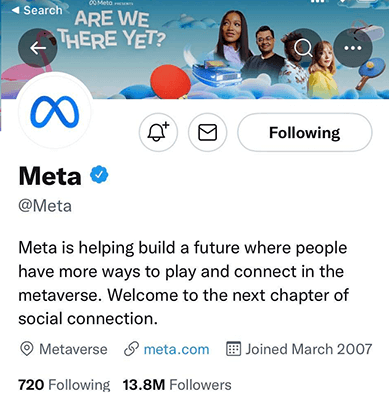
Oh, and don’t forget, always include a link in your bio so that followers can continue to explore your brand if they wish to!
2. Choose a brand name and create a logo
When building a brand on social media, it’s really important to choose a name and stick with it.
Followers need to know how to search for your brand and how to refer to it in order for your brand to see real growth. Therefore, avoid changing your business name, or creating multiple accounts under different names.
Once you’ve decided on your name, you can then create a logo. Your logo will become synonymous with your brand, so make sure to choose colors and graphics that are in keeping with your brand image and the messages you’re trying to convey.
Creating a logo is really easy. You can pay a professional graphic designer, or you can design one yourself on sites like Canva. When designing your logo, try to think about color psychology. Different colors connote different feelings and ideas, so it’s a good idea to choose a color that is in keeping with your brand message.
For example, the color gold is associated with luxury, which is why many luxury brands such as Versace use this color in their logo. We’ve got a full guide to color psychology that’s worth checking out when designing your logo.
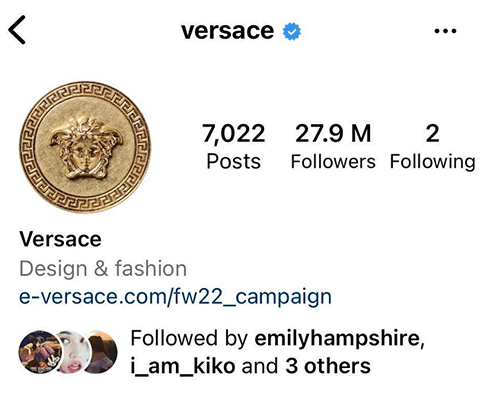
In addition, tie your social media branding in with your brand identity on your website. Use the same brand name, colors and logos etc. This will create a sense of familiarity across different social media networks, and other platforms you’re featured on.
3. Develop your brand voice
The tone that you use within your writing on social media is known as a ‘voice’, and it’s super important to keep this voice consistent and suitable for your brand.
The tone, or voice that you choose should reflect your brand and its values and be suitable for your target audience.
For example, if your target audience is young people, it might be appropriate to use slang terms and include internet memes and jokes within your writing. However, if your brand is a law firm, then you would probably want to keep your tone informative and professional.
Here are some examples of different tones of voice used in social media posts:
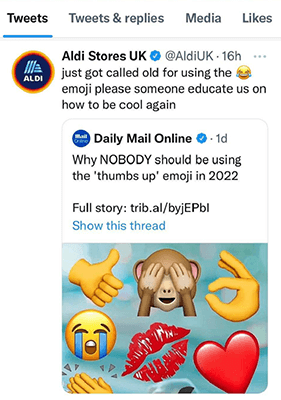
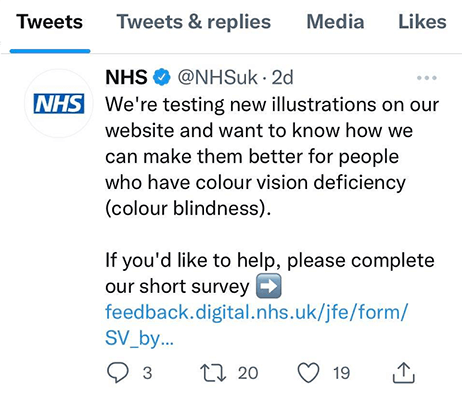
Whatever voice you choose for your social media posts, it’s important to keep it consistent across all posts and on each social media channel. This will help to develop your branding and build a strong connection with your audience.
Engagement strategies
4. Make use of user-generated content
Engaging with your audience is a great way to improve brand sentiment and grow on social media.
One of the easiest and most effective ways to do this is through the use of UGC. UGC stands for user generated content, and it refers to content that has been created by followers and other social media users.
For example, social media users might purchase something from your brand and post about it on Instagram, and tag your brand. You could then reshare this post to your own socials to create engagement opportunities with your followers, and boost your own content output for the day.
If you want to take advantage of UGC at scale, you can also run campaigns to encourage your followers to create content. For example, Coca-Cola recently launched a social media marketing campaign that encourages customers to use the hashtag #shareacoke if they found their name on a coke bottle in stores.

This created tons of engagement between the brand and its followers and got people talking about the brand across different social media channels.
5. Create and join online communities
If you want to build a brand that has a personal connection with followers, then it’s a good idea to get involved in communities within your target audience or create your own.
For example, if you are building a brand related to gaming, it may be worth joining Twitch or Discord communities where your target audience hangs out and chat.
You may also want to consider creating your own community groups online that can become a hub for followers old and new to meet each other and learn more about your products and upcoming events.
This social media branding strategy is particularly effective for smaller brands that find it hard to create a large social media presence and stand out.
6. Respond to comments and DM’s with consistency
One of the easiest and most effective ways to build a good reputation for your brand on social media is to engage with your followers in the comments and in your DM’s.
It might seem like a difficult task to respond to all your comments and messages, but it really does have a positive effect on engagement rates and brand sentiment.
If you’re struggling to stay on top of comments and DM’s, it’s a good idea to invest in a tool that has a unified social inbox like Pallyy.
This will display all your social media messages and comments in one place to make it more simple for you and your team to keep track of and respond to your followers.

And remember, when responding to your followers, make sure you maintain a consistent voice and are polite and friendly!
Influencer marketing strategies
7. Connect and collaborate with Influencers
Influencers are the foundation of social media, and it’s super important for brands to connect and collaborate with influencers in their niche.
There are tons of ways you can do this, from paying influencers to promote your brand and collaborate on social media content to gifting products to influencers in order to get a mention from them.
When it comes to influencer marketing, the first thing you need to do is establish which influencers are the most popular among your target audience. Then, you can reach out to the influencers and start building a relationship.
You don’t even need to propose a collaboration straight away. To get started, you can simply connect with the influencers by interacting with their content and making comments on their posts.
This will help to make your brand more visible in your chosen space, and will also help you to organically build a relationship with key influencers in the community.
8. Try influencer takeovers and live streams
Another fun and engaging way to utilize influencers in your social media branding strategies is through takeovers and live streams.
Many brands allow popular influencers to ‘take over’ their social media accounts for the day in order to draw in new followers from their target audience. The influencers can post stories and feed posts, field questions from followers, and more.
These takeovers are extremely popular amongst social media users and they are a great way to get a quick boost in followers and engagement. Here’s an example of social media takeovers from goop:
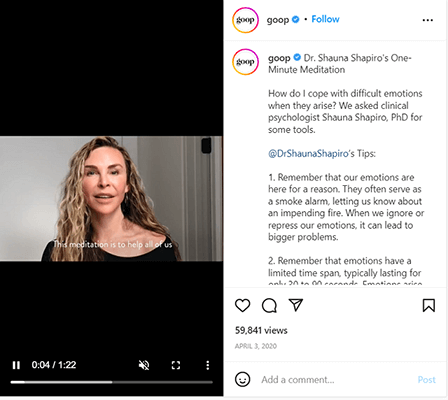
Another popular method to use is collaborative live streaming. Your brand rep and the influencer can both join a live stream together and have a unique opportunity to engage and talk with your followers and other members of your target audience.
This is a great way to create hype around your brand, and it’s a good choice if you’re launching a new product that your target audience may want to ask questions about.
Planning and scheduling strategies
9. Work out the best time to post for your target audience
Another great trick for building your brand and growing your audience is to post consistently at an optimal time. You’ll want to choose a time when your followers are the most active to increase visibility and engagement on your posts.
Although there are some general rules about the best time to post on social media, it really depends on your business and your audience. The only way to really establish the best time to post is through trial and error and close monitoring.
Start by publishing similar posts at different times throughout the day on each of your social media platforms.
Over the course of a month or so, track and monitor each post’s performance to see which ones got the most views, likes, and comments.
If you have a couple of times that seemed more popular than the others, try those times the following month to see which one performed best.
After a period of time, you’ll have a good idea of when your followers are the most active, and when they’re most likely to see and engage with your posts. The time may vary for each platform too, so it’s worth carrying out similar tests on each one.
You can use the analytics functionality offered natively by your social media platform of choice for this. For example, Instagram, Twitter, and TikTok all have decent built-in analytics. Alternatively, you may need the help of a social media analytics tool like Iconosquare.
10. Use a scheduling tool to keep your social media posting organized and consistent
Consistency is key to growing a brand on social media, so it’s a good idea to create an organized schedule for your upcoming posts.
When you have more than one social media platform to think about, it can be quite hard to stay on top of things, but thankfully, there are tons of great tools available that will help you manage all of your social media accounts from one unified calendar.
One of our favorite social media scheduling tools is Pallyy. You can use it to schedule all of your social media posts in advance for different platforms, and it also has a unified social inbox too, which will help you stay on track with comments and DMs.
You can use a scheduling tool like Pallyy to create a set schedule of when you’re going to posts and how frequently.
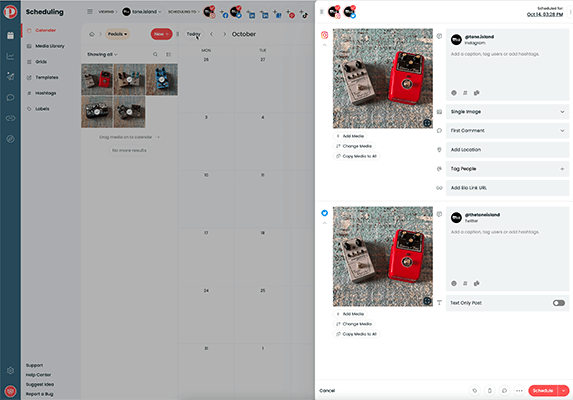
This consistency will help your followers to know what to expect from your brand, and when to expect it. And therefore, they’ll be more likely to engage with your posts, and seek out new posts on your feed if they think they have missed one.
Scheduling posts in advance can also help you to avoid inactivity on social media which can be damaging to your brand’s image, particularly when it comes to new customers searching for information about your brand.
Monitoring and analysis strategies
11. Track post performance across platforms
When building your brand on social media, it’s important to know exactly how your posts are performing and how you can develop your strategy to gain more followers. To do this, you should try to track all of your activity on all the different social platforms to see if there are any trends emerging.
For example, you might find that your Instagram posts perform very well and have great reach, whereas your Twitter posts are receiving little to no engagement.
This type of analysis will give you a better idea of which platforms your target audience like to use and which platforms are best to try and focus on.
You can also track individual posts to see which ones perform the best and garner the most engagement. If you find that static image posts aren’t performing well, but video posts and stories generate lots of comments and engagement, then you can adapt your strategy accordingly.
If you’re using many different platforms, then it’s a good idea to invest in a social media analytics tool that will provide data and insights for all of your social media content, so that it’s easier to compare performance for different platforms and content types. Tools like Social Status and Agorapulse are great for this.
As a side note, you can also use Social Status to track and uncover insights about your competitors on social media:
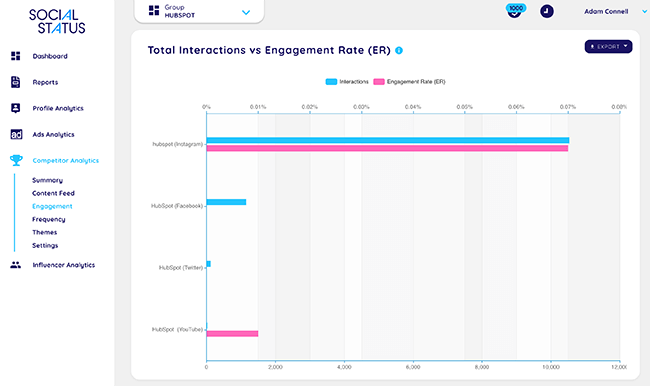
12. Monitor brand mentions
When growing your social media following, it’s a good idea to keep a close eye on what people are saying about your brand online.
You can use information about brand mentions to help guide your social media marketing strategy and to ensure that you are monitoring and managing any interactions that could harm your brand and its reputation. Brand monitoring is super easy with the help of tools like Brand24.
Simply sign up for the tool and input your brand names or related hashtags, and you’ll be able to view all mentions of your brand across social media, blogs, podcasts, and more. Basically, if your brand was mentioned on the internet, you’ll know about it!
You can also use brand monitoring tools to see if mentions of your brand are increasing or decreasing over time, and you can use them to gauge the success of social media campaigns.
For example, if you launch a UGC campaign, you can use brand monitoring to see if your mentions increased as a result.
Final thoughts
So there you have it, 12 actionable strategies that will help you to improve your social media branding efforts and grow your audience.
If you’re looking for more tips and tricks for developing your social media strategy, be sure to check out our full guide on the topic: How To Build A Social Media Marketing Strategy.
Also, if you’re keen to learn more about social media marketing in general, check out some of our other posts including 11 Essential Social Media Skills Every Social Media Manager Needs To Have and The Latest Social Media Statistics And Trends.
Disclosure: Our content is reader-supported. If you click on certain links we may make a commission.
